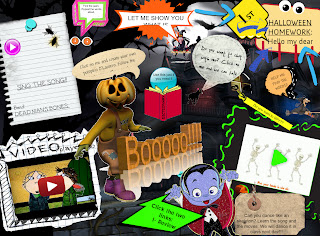When reading in the classroom, You can choose a story (a traditional tale, a reader, a video story, etc.) or any other (complete) written text that you like.
According to the introduction of Grellet's Reading Strategies for Developing Reading Skills (pages 3-25) we considered what you learnt when you read it when planning the way to implement this story in a level of the primary education.
3rd cycle of primary: 5th grade
Pre-reading:
Arrangement: circle to tell stories.
First, teacher shows the storybook to pupils in order to enhance their curiosity and anticipate the content of the story (Previewing and Predicting). They watch the pictures of the book and the teacher will ask questions such as: What are they? Are they bulls? Are they buffalos? Are they bears? How they look like? Do they have horns? Do they have any tail? Where are they?
They pass the pages of the book trying to guessing what happens, helped by the questions the teacher asks. This way the pupils can develop their powers of inference and anticipate the content because when learning to approach reading it is always better to start from the most general to the most particular. Hence, after understanding the plot and main events of the story, they will focus on things like vocabulary or something more specific.
After have seen and guessed what happens in the book, the teacher reads the story aloud so that they can check if their suppositions were right and the pupils will have a reference of the sounds, pace and intonation of the text (pronunciation, stress, rhythm and variation). The teacher will encourage participation through repetition of the refrain (such as “The snow fell fast and the wind blew wild”).
While-reading:
The pupils read the text silently, because when reading aloud they can not focus well on understanding. Also, while reading pupils will have to recognize the important elements of the passage through complete this chart (this way pupils will learn to do Skimming, because the things that they will have to take into account are the key to understand quickly the text). It is important to give them exercises with no straightforward answers, such as this star:
If they find any word they do not know the meaning, they will try to find it through the context: relating it with the pictures and asking a partner (no more than 5 words each because later the individual reading they will be arranged in groups and will share their new vocabulary). Finally, they can check in the dictionary or ask the teacher.
After reading, they will be provided two split hand outs. One with the Big Bad Mouse's parts of the body and another with the description of his physical appearance, with which pupils will have to match the sentences to the picture and complete the sentences with one missing word.


In addition, they will compare the characters of the story using these pictures: How the Gruffalo's child knows the snake, the fox or the owl are not the Big Bad Mouse? What evidence can you find? (
Scanning).
In pairs, they compare their hand-outs and answer the following questions justifying their answers:
1. Give your opinion about the end of the story. (The teacher may invite them to read again the end of the story to formulate their opinions and justify them through learning to do intensive reading).
2. Image that you are a Gruffalo’s Child. What will you do if you see a Big Bad Mouse?
Post-Reading:
Group work. They will share their previous answers and will come to a group conclusion.
Then, they will decide if the Mouse was friendly or not. Finally, they will create a different ending for the story and every group will tell it to the rest of the class using what they want to show it, e.g. role-playing, reading a new ending, creating a song, etc...
During this activity we formulated
6 questions related to the text (
2 for each of the Bloom's Taxonomy higher-order thinking skills: Analyse, Evaluate, Create):
Analyse
What happens in the story? Write it down using this star as a guide.

How the Gruffalo's child knows the snake, the fox or the owl are not the Big Bad Mouse? What evidence can you find? (Compare the characters of the story).
Evaluate
1. What do you think about the end of the story? the end of the sad or happy ending? Give your opinion about the end of the story.
2. Decide in groups. How would you prove the Mouse was friendly or not?
Create
1. Can you invent/create a new ending for the story?
2. Image that you are a Gruffalo’s Child. What will you do if you see a Big Bad Mouse?































